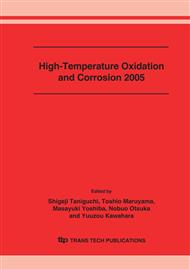[1]
C. T. Fujii and R. A. Meussner, J. Electrochem. Soc. Vol. 111 (1964), p.1215.
Google Scholar
[2]
A. Rahmel and J. Tobolski, Corros. Sci. Vol. 5 (1965), p.333.
Google Scholar
[3]
K. Kusabiraki, T. Sugihara, and T. Ooka, Tetsu-to-Hagane Vol. 77 (1991), p.123.
Google Scholar
[4]
A. Yamauchi, K. Kurokawa, H. Takahashi, and Y. Takada: J. Japan Inst. Metals Vol. 64 (2000), p.359.
Google Scholar
[5]
A. Yamauchi, K. Kurokawa, H. Takahashi, and Y. Takada: Materials at High Temperatures Vol. 18 (2001), p.111 N2-3%O2 (N2-3%O2)-19. 7%H2O a b.
Google Scholar
[6]
C. S. Tedmond Jr.: J. Electrochem. Soc. Vol. 113 (1966), p.766.
Google Scholar
[7]
H. C. Graham and H. H. Davis: J. Amer. Ceram. Soc. Vol. 54 (1971), p.89.
Google Scholar
[8]
C. A. Stearns, F. J. Kohl, and G. C. Fryburg: J. Electrochem. Soc. Vol. 121 (1974), p.945.
Google Scholar
[9]
Y-W Kim, and G. R. Belton: Met. Trans. Vol. 5 (1974), p.1811.
Google Scholar
[10]
B. B. Ebbinghaus: Combust. Flame Vol. 93 (1993), p.119.
Google Scholar
[11]
H. Asteman, J. -E. Svensson, L. -G. Johansson, and M. Norell: Oxid. Met. Vol. 52 (1999), p.95.
Google Scholar
[12]
H. Asteman, J. -E. Svensson, M. Norell, and L. -G. Johansson: Oxid. Met. Vol. 54 (2000), p.11.
Google Scholar
[13]
A. Yamauchi, K. Kurokawa, and H. Takahashi: Oxid. Met. Vol. 59 (2003), p.517.
Google Scholar
[14]
I. Kvernes, M. Oliveira, and P. Kofstad: Corros. Sci. Vol. 17 (1977), p.237.
Google Scholar
[15]
P. Kofstad: Oxid. Met. Vol. 24 (1985), p.265.
Google Scholar
[16]
P. Kofstad: High-Temperature Corrosion, (Elsevier Applied Science, London 1988).
Google Scholar
[17]
S. Jianian, Z. Longjiang and L. Tiefan: Oxid. Met. Vol. 48 (1997), p.347.
DOI: 10.1007/bf01670507
Google Scholar
[18]
T. Norby: J. Phys. � Vol. 3 (1993), p.99.
Google Scholar
[19]
G. Hultquist, B. Tveten, and E. Hornlund: Oxid. Met. Vol. 54 (2000), p.1.
Google Scholar
[20]
B. Tveten, G. Hultquist, and T. Norby: Oxid. Met. Vol. 52 (1999), p.221.
Google Scholar
[21]
B. Tveten, G. Hultquist, and D. Wallinder: Oxid. Met. Vol. 55 (2001), p.279.
Google Scholar
[22]
H. Yanagihara, I. Fujita, T. Hino and T. Yamashina: J. Nucl. Mater. Vol. 220-222 (1995), p.856.
Google Scholar
[23]
H. Yanagihara, Y. Yamauchi, T. Hino, Y. Hirohata, and T. Yamashina: J. Nucl. Mater. Vol. 241-243 (1997), p.1098.
Google Scholar
[24]
Y. Aihara: Master Eng. Thesis, Hokkaido University, (1996).
Google Scholar


